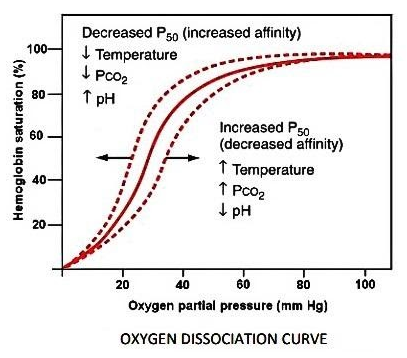
Describe the oxy-hemoglobin dissociation curve.
Answer
491.4k+ views
Hint: This curve plots the proportion of hemoglobin in its saturated form on the vertical axis against the oxygen tension on the horizontal axis and is of sigmoid shape.
Complete answer:
The transport of the oxygen from the lungs to the target tissues of the body by the blood is due to the ability of hemoglobin to combine reversibly by the oxygen.
At a tension of 100 mm Hg or more than this, the hemoglobin is completely saturated. The function of hemoglobin is to carry oxygen in the blood.
The vital relationship between the saturation of hemoglobin and the oxygen tension is shown by the dissociation curve in which percent saturation is plotted with the oxygen tension. The curve is drawn with carbonic oxide at a tension of 40 mm of Hg, this is considered as representative of normal physiological condition.
The hemoglobin in this condition is 94 – 98% saturated in the arterial blood. This saturation of hemoglobin declines slowly with the fall in oxygen tension and rapid unloading of oxygen takes place at the oxygen tension of 50 mm Hg. This is the unloading tension of hemoglobin.
While in tissues the oxygen tension is about 40 mm of Hg which helps in the dissociation of the oxy-hemoglobin complex making the oxygen readily available to the cells.

Additional Information:
Factors affecting Dissociation of Oxy-haemoglobin-
-temperature
- The rise in temperature leads to a decrease in the hemoglobin saturation.
-Effect of carbon dioxide
-The influence of carbon dioxide on the shape of the dissociation curve is the effect of the formation of carbonic acid.
-The carbonic acid makes the pH go lower and creates an acidity which facilitates the dissociation of oxy-hemoglobin.
-This ability of carbon dioxide to shift the curve to the right is called a Bohr effect.
Note:
When hemoglobin combines with carbon monoxide the complex carboxyhemoglobin is formed. Which in turn reduces the amount of hemoglobin to carry oxygen.
When the decrease in the normal oxygen concentration happens then it results in the formation of bluish skin which is called cyanosis.
Complete answer:
The transport of the oxygen from the lungs to the target tissues of the body by the blood is due to the ability of hemoglobin to combine reversibly by the oxygen.
At a tension of 100 mm Hg or more than this, the hemoglobin is completely saturated. The function of hemoglobin is to carry oxygen in the blood.
The vital relationship between the saturation of hemoglobin and the oxygen tension is shown by the dissociation curve in which percent saturation is plotted with the oxygen tension. The curve is drawn with carbonic oxide at a tension of 40 mm of Hg, this is considered as representative of normal physiological condition.
The hemoglobin in this condition is 94 – 98% saturated in the arterial blood. This saturation of hemoglobin declines slowly with the fall in oxygen tension and rapid unloading of oxygen takes place at the oxygen tension of 50 mm Hg. This is the unloading tension of hemoglobin.
While in tissues the oxygen tension is about 40 mm of Hg which helps in the dissociation of the oxy-hemoglobin complex making the oxygen readily available to the cells.

Additional Information:
Factors affecting Dissociation of Oxy-haemoglobin-
-temperature
- The rise in temperature leads to a decrease in the hemoglobin saturation.
-Effect of carbon dioxide
-The influence of carbon dioxide on the shape of the dissociation curve is the effect of the formation of carbonic acid.
-The carbonic acid makes the pH go lower and creates an acidity which facilitates the dissociation of oxy-hemoglobin.
-This ability of carbon dioxide to shift the curve to the right is called a Bohr effect.
Note:
When hemoglobin combines with carbon monoxide the complex carboxyhemoglobin is formed. Which in turn reduces the amount of hemoglobin to carry oxygen.
When the decrease in the normal oxygen concentration happens then it results in the formation of bluish skin which is called cyanosis.
Recently Updated Pages
The correct geometry and hybridization for XeF4 are class 11 chemistry CBSE

Water softening by Clarks process uses ACalcium bicarbonate class 11 chemistry CBSE

With reference to graphite and diamond which of the class 11 chemistry CBSE

A certain household has consumed 250 units of energy class 11 physics CBSE

The lightest metal known is A beryllium B lithium C class 11 chemistry CBSE

What is the formula mass of the iodine molecule class 11 chemistry CBSE

Trending doubts
State the laws of reflection of light

One Metric ton is equal to kg A 10000 B 1000 C 100 class 11 physics CBSE

Difference Between Prokaryotic Cells and Eukaryotic Cells

How do I convert ms to kmh Give an example class 11 physics CBSE

Describe the effects of the Second World War class 11 social science CBSE

Which of the following methods is suitable for preventing class 11 chemistry CBSE




